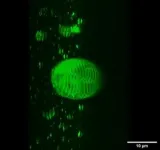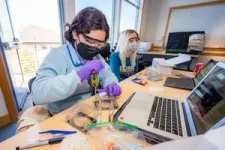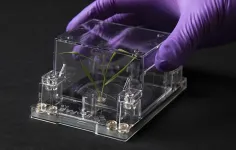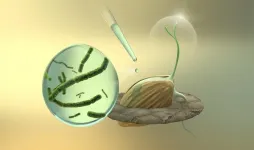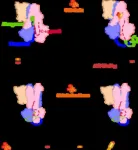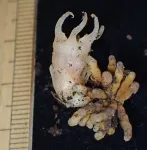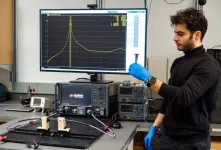(Press-News.org) LA JOLLA, CA—Roughly 4 billion years ago, Earth was developing conditions suitable for life. Origin-of-life scientists often wonder if the type of chemistry found on the early Earth was similar to what life requires today. They know that spherical collections of fats, called protocells, were the precursor to cells during this emergence of life. But how did simple protocells first arise and diversify to eventually lead to life on Earth?
Now, Scripps Research scientists have discovered one plausible pathway for how protocells may have first formed and chemically progressed to allow for a diversity of functions.
The findings, published online on February 29, 2024, in the journal Chem, suggest that a chemical process called phosphorylation (where phosphate groups are added to the molecule) may have occurred earlier than previously expected. This would lead to more structurally complex, double chained protocells capable of harboring chemical reactions and dividing with a diverse range of functionalities. By revealing how protocells formed, scientists can better understand how early evolution could have taken place.
“At some point, we all wonder where we came from. We’ve now discovered a plausible way that phosphates could have been incorporated into cell-like structures earlier than previously thought, which lays the building blocks for life,” says Ramanarayanan Krishnamurthy, PhD, co-corresponding senior author and professor in the Department of Chemistry at Scripps Research. “This finding helps us better understand the chemical environments of early Earth so we can uncover the origins of life and how life can evolve on early Earth.”
Krishnamurthy and his team study how chemical processes occurred to cause the simple chemicals and formations that were present before the emergence of life in prebiotic Earth. Krishnamurthy is also a co-leader of a NASA initiative investigating how life emerged from these early environments.
In this study, Krishnamurthy and his team collaborated with the lab of soft matter biophysicist Ashok Deniz, PhD, co-corresponding senior author and professor in the Department of Integrative Structural and Computational Biology at Scripps Research. They sought to examine if phosphates may have been involved during the formation of protocells. Phosphates are present in nearly every chemical reaction in the body, so Krishnamurthy suspected they may have been present earlier than previously believed.
Scientists thought protocells formed from fatty acids, but it was unclear how protocells transitioned from a single chain to a double chain of phosphates, which is what allows them to be more stable and harbor chemical reactions.
The scientists wanted to mimic plausible prebiotic conditions—the environments that existed prior to the emergence of life. They first identified three likely mixtures of chemicals that could potentially create vesicles, spherical structures of lipids similar to protocells. The chemicals used included fatty acids and glycerol (a common byproduct of soap production that may have existed during early Earth). Next, they observed the reactions of these mixtures and added additional chemicals to create new mixtures. These solutions were cooled and heated on repeat overnight with some shaking to promote chemical reactions.
They then used fluorescent dyes to inspect the mixtures and judge if vesicle formation had taken place. In certain cases, the researchers also varied the pH and the ratios of the components to better understand how these factors impacted vesicle formation. They also looked at the effect of metal ions and temperature on the stability of the vesicles.
“The vesicles were able to transition from a fatty acid environment to a phospholipid environment during our experiments, suggesting a similar chemical environment could have existed 4 billion years ago,” says first author Sunil Pulletikurti, postdoctoral researcher in Krishnamurthy’s lab.
It turns out that fatty acids and glycerol may have undergone phosphorylation to create that more stable, double chain structure. In particular, glycerol derived fatty acid esters may have led to vesicles with different tolerances to metal ions, temperatures, and pH—a critical step in diversifying evolution.
“We’ve discovered one plausible pathway for how phospholipids could have emerged during this chemical evolutionary process,” says Deniz. “It’s exciting to uncover how early chemistries may have transitioned to allow for life on Earth. Our findings also hint at a wealth of intriguing physics that may have played key functional roles along the way to modern cells.”
Next, the scientists plan to examine why some of the vesicles fused while others divided to better understand the dynamic processes of protocells.
Authors of the study, “Experimentally Modeling the Emergence of Prebiotically Plausible Phospholipid Vesicles” include Sunil Pulletikurti, Veena S. Kollery, Mahipal Yadav, Ashok A. Deniz, and Ramanarayanan Krishnamurthy of Scripps Research.
The work was supported by the NASA Astrobiology-Exobiology (grant 80NSSC20K0625) and Simons Foundation (grant 327124FY19).
About Scripps Research
Scripps Research is an independent, nonprofit biomedical institute ranked one of the most influential in the world for its impact on innovation by Nature Index. We are advancing human health through profound discoveries that address pressing medical concerns around the globe. Our drug discovery and development division, Calibr, works hand-in-hand with scientists across disciplines to bring new medicines to patients as quickly and efficiently as possible, while teams at Scripps Research Translational Institute harness genomics, digital medicine and cutting-edge informatics to understand individual health and render more effective healthcare. Scripps Research also trains the next generation of leading scientists at our Skaggs Graduate School, consistently named among the top 10 US programs for chemistry and biological sciences. Learn more at www.scripps.edu.
END
Scripps Research scientists reveal how first cells could have formed on Earth
New phospholipid discovery brings researchers closer to understanding how primordial cells emerged during origin of life.
2024-02-29
ELSE PRESS RELEASES FROM THIS DATE:
EcoFABs could lead to better bioenergy crops
2024-02-29
– By Will Ferguson
A greater understanding of how plants and microbes work together to store vast amounts of atmospheric carbon in the soil will help in the design of better bioenergy crops for the fight against climate change.
Deciphering the mechanics of this mutually beneficial relationship is challenging, however, as conditions in nature are extremely difficult for scientists to replicate in the laboratory. To address this challenge, researchers at Lawrence Berkeley National Laboratory (Berkeley Lab) created fabricated ecosystems or EcoFABs.
In a new paper in Science Advances, they ...
Digital Science announces Catalyst Grant winners, supporting AI-based innovations to benefit research
2024-02-29
Digital Science has awarded two new Catalyst Grants of £25,000 each to innovative AI-based technology ideas aimed at advancing global research.
The winners will use the funding to develop their ideas, which include using AI to alleviate the burden on researchers of applying for research funding, and to predict research impact.
The winning applications from Digital Science’s 2023 Catalyst Grant round announced today are:
Atom – Tomer du Sautoy (co-founder and CEO) and Hamilton Evans (co-founder and ...
Targeting seed microbes to improve seed resilience
2024-02-29
Fonio (Digitaria exilis), a type of millet, is the oldest indigenous crop in West Africa and one of the fastest maturing cereals. Despite its low yield, the combination of quick maturation and drought tolerance and its ability to thrive in poor soils make it a useful model for understanding how cereals can adapt to future climate change conditions.
Nutritionally, fonio is comparable to other millets, says KAUST researcher Naheed Tabassum, but yields are much lower than the major cereal crops rice, maize and wheat. Tabassum believes fonio could complement staple crops amid climate change and desertification ...
Astronomers discover heavy elements after bright gamma-ray burst from neutron star merger
2024-02-29
An international team of astronomers — including Clemson University astrophysicist Dieter Hartmann — obtained observational evidence for the creation of rare heavy elements in the aftermath of a cataclysmic explosion triggered by the merger of two neutron stars.
The massive explosion unleashed a gamma-ray burst, GRB230307A, the second brightest in 50 years of observations and about 1,000 times brighter than a typical gamma-ray burst. GRB230307A was first detected by NASA’s Fermi Gamma-Ray Space Telescope on March 7, 2023.
Using multiple space- and ground-based ...
USTC reveals molecular mechanism of transmembrane bilirubin transport by human ABCC2 transporter
2024-02-29
The metabolic process of bilirubin has been a focus in medical research since the abnormal accumulation of bilirubin has been found to be associated with a variety of diseases. Bilirubin is a substance produced by the breakdown of aging or damaged red blood cells, and its effective removal is essential for human health.
A research team led by Prof. CHEN Yuxing and Prof. ZHOU Congzhao from the University of Science and Technology of China (USTC) of the Chinese Academy of Sciences has revealed the three-dimensional structure and working mechanism of the human bilirubin transporter ABCC2. The study was published ...
USTC realizes durable CO2 conversion in proton-exchange membrane system
2024-02-29
The metabolic process of bilirubin has been a focus in medical research since the abnormal accumulation of bilirubin has been found to be associated with a variety of diseases. Bilirubin is a substance produced by the breakdown of aging or damaged red blood cells, and its effective removal is essential for human health.
A research team led by Prof. CHEN Yuxing and Prof. ZHOU Congzhao from the University of Science and Technology of China (USTC) of the Chinese Academy of Sciences has revealed ...
A new plant’s name that tells a story
2024-02-29
A new species and genus of fairy lantern, tiny glass-like white plants that feed on fungi, has been discovered in Japan. In the country renowned for its extensive flora research, the discovery of a new plant genus is extremely rare and has not occurred in almost 100 years.
Fairy lanterns, or Thismiaceae as they are known to botany, are very unusual plants found mainly in tropical but also in subtropical and temperate regions. First of all, they are not green and do not engage in photosynthesis, but rather feed on fungal mycelia in the ground. As a consequence, they are often hidden under fallen leaves and only for a brief period produce above-ground flowers that look like glasswork. The ...
Noteworthy studies to be presented at the 2024 Multidisciplinary Head & Neck Cancers Symposium
2024-02-29
PHOENIX, February 29, 2024 — Research on patient-centered treatment of head and neck cancers will be presented at the 2024 Multidisciplinary Head and Neck Cancers Symposium, which takes place in Phoenix and online today through March 2. Media registration is available via our press kit, and general registration is available via the meeting website.
Seven high-impact studies recommended by symposium leadership for media are noted below. All abstracts are available online. Experts are available to provide outside commentary and perspective on research at the meeting; ...
Turbocharging CRISPR to understand how the immune system fights cancer
2024-02-29
Over the past two decades, the immune system has attracted increasing attention for its role in fighting cancer. As researchers have learned more and more about the cancer-immune system interplay, several antitumor immunotherapies have become FDA-approved and are now regularly used to treat multiple cancer types.
Yet despite these advances, much remains unknown about how the immune system fights cancer — and about immunity in general, said Martin LaFleur, a postdoctoral fellow in the laboratory of Arlene ...
UBC Okanagan researchers create new compound to build space-age antennas
2024-02-29
In a first-of-its-kind development, UBC Okanagan researchers, in collaboration with Drexel University, have created a new compound that can be used to 3D print telecommunication antennas and other connectivity devices.
These 3D printed products, created by combining a two-dimensional compound called MXenes with a polymer, can be used as an alternative for metallic counterparts and can make a vast improvement in communication technology including elements such as antennas, waveguides and filters.
Waveguides are everywhere, yet most people don’t know what they are, says Dr. Mohammad Zarifi, a researcher in UBC Okanagan’s Microelectronics and Gigahertz ...
LAST 30 PRESS RELEASES:
Orthopedics can play critical role in identifying intimate partner violence
Worms as particle sweepers
Second spider-parasitic mite described in Brazil
January 2026 issues of APA journals feature new research on autism, pediatric anxiety, psychedelic therapy, suicide prevention and more
Private equity acquired more than 500 autism centers over the past decade, new study shows
New cervical cancer screening guidelines from the US Department of Health and Human Services
Estimated burden of COVID-19 illnesses, medical visits, hospitalizations, and deaths in the US from October 2022 to September 2024
Smartphone use during school hours by US youth
Food insecurity and adverse social conditions tied to increased risk of long COVID in children
Earliest, hottest galaxy cluster gas on record could change our cosmological models
Greenland’s Prudhoe Dome ice cap was completely gone only 7,000 years ago, first GreenDrill study finds
Scientific validity of blue zones longevity research confirmed
Injectable breast ‘implant’ offers alternative to traditional surgeries
Neuroscientists devise formulas to measure multilingualism
New prostate cancer trial seeks to reduce toxicity without sacrificing efficacy
Geometry shapes life
A CRISPR screen reveals many previously unrecognized genes required for brain development and a new neurodevelopmental disorder
Hot flush treatment has anti-breast cancer activity, study finds
Securing AI systems against growing cybersecurity threats
Longest observation of an active solar region
Why nail-biting, procrastination and other self-sabotaging behaviors are rooted in survival instincts
Regional variations in mechanical properties of porcine leptomeninges
Artificial empathy in therapy and healthcare: advancements in interpersonal interaction technologies
Why some brains switch gears more efficiently than others
UVA’s Jundong Li wins ICDM’S 2025 Tao Li Award for data mining, machine learning
UVA’s low-power, high-performance computer power player Mircea Stan earns National Academy of Inventors fellowship
Not playing by the rules: USU researcher explores filamentous algae dynamics in rivers
Do our body clocks influence our risk of dementia?
Anthropologists offer new evidence of bipedalism in long-debated fossil discovery
Safer receipt paper from wood
[Press-News.org] Scripps Research scientists reveal how first cells could have formed on EarthNew phospholipid discovery brings researchers closer to understanding how primordial cells emerged during origin of life.

